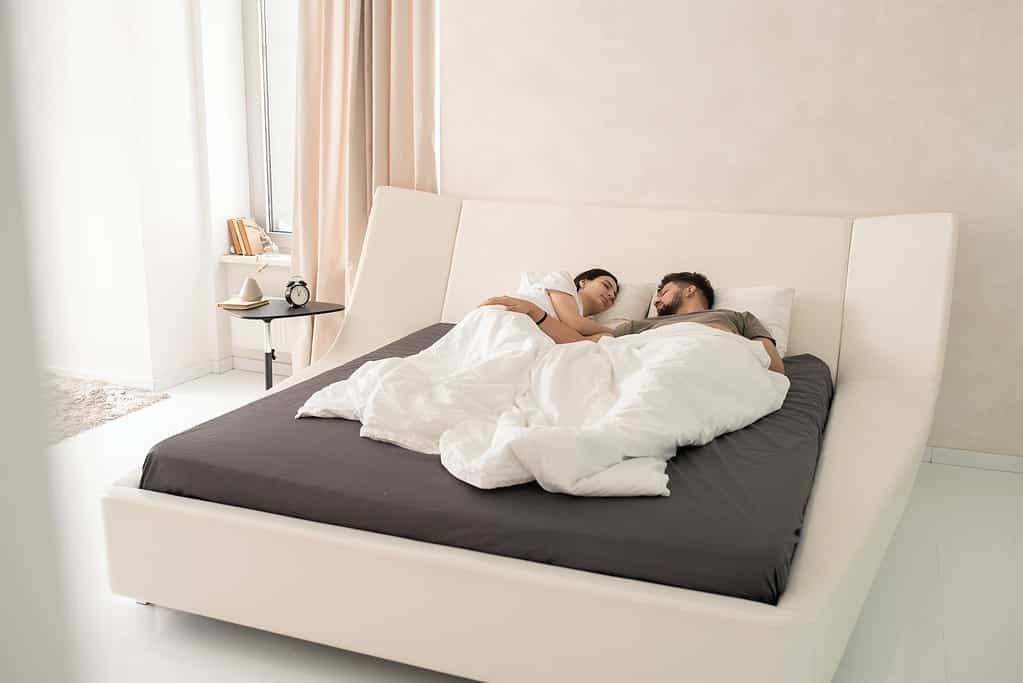Mattress Allergies: Tips for Allergy-Proofing Your Bed for a Better Night’s Sleep
As someone who’s experienced mattress allergies, I know how frustrating it can be to wake up sneezing, itching, and runny nose. Allergens lurking in our mattresses can make a good night’s sleep impossible, leaving us exhausted and irritated the next day. But don’t worry; I’m here to share some tips on allergy-proofing your bed and getting a better night’s sleep. It’s essential to identify the common allergens in your mattress, like dust mites, mould, and pet dander. Once you know what’s causing your allergies, you can act against them. There are allergy-proofing methods available that can help create a healthier sleep environment.
In the following paragraphs, I’ll guide you through some simple yet effective ways to minimise allergens and get a restful sleep. We’ll discuss using allergen-proof covers, cleaning practices, and other valuable strategies. With these tips at hand, you’ll be well on your way to a night free of mattress allergies and full of serene slumber.
Common Mattress Allergens
Look at common culprits lurking in your mattress and causing those pesky allergies. Trust me, once you know what you’re up against, you can take the proper measures to allergy-proof your bed and get that better night’s sleep you deserve.
- The most common allergen you’ll find in mattresses is dust mites. These tiny creatures feast on dead skin cells and thrive in warm, humid environments. It’s not the dust mites that cause allergies but their droppings and the remains that get left behind. Ugh, I know, not the most pleasant thought, but don’t worry, I have some tips to help combat these little pests.
- Another common allergen, especially for those with pet allergies, is animal dander. Yeah, as much as we love our furry friends, they can cause a bit of an issue regarding allergies. Whether it’s your pets sleeping on your bed or just the dander being carried in from elsewhere, it can build up in your mattress and cause allergic reactions.
- Mould is another allergen that can be found in mattresses. If your bedroom is damp or has high humidity levels, it creates the perfect environment for mould to grow. Not only can it trigger allergies, but mould can also lead to respiratory issues, so keeping your sleeping environment clean and dry is essential.
Alright, so those are some of the most common allergens you might find in your mattress. But fear not; there are steps you can take to allergy-proof your bed and achieve a better night’s sleep. Allergy-proofing your home includes regular cleaning and vacuuming, investing in allergen-proof bedding, and controlling the humidity in your bedroom. With a little effort, you can sleep soundly and allergy-free!
Signs of a Mattress Allergy
As someone who’s dealt with allergies, I know how important it is to allergy-proof your bed for a better night’s sleep. So, let me share the signs of a mattress allergy and some helpful tips.
Physical Symptoms
When I experienced mattress allergies, the first thing I noticed was the physical symptoms. These can include:
- Sneezing
- Runny nose
- Itchy eyes or skin
- Rashes or hives
Sleep Quality
Another sign of a mattress allergy is a decrease in sleep quality. I realised that I was constantly waking up in the middle of the night or struggling to fall asleep due to my allergy symptoms. Keep an eye out for these indications that your mattress might be causing issues:
- Tossing and turning
- Difficulty falling asleep
- Frequently waking up during the night
- Feeling unrested in the morning
Choosing the Right Allergy-Proof Mattress
Let me share some helpful information on selecting the right allergy-proof mattress with a focus on materials and certifications.
Materials
Regarding materials, certain types can be more allergy-friendly than others. For instance, memory foam and latex mattresses are naturally hypoallergenic, resisting dust mites and mould. I recommend looking for a mattress made from these materials, as they can help alleviate allergy symptoms. Another option is to choose a mattress with a removable and washable cover. This lets me easily clean the cover, removing allergens like dust mites and pet dander. Moreover, consider investing in an allergy-proof mattress protector to add a layer of defence against allergens.
Certifications
Certifications can provide an extra level of assurance when picking an allergy-proof mattress. One necessary certification to look for is the Oeko-Tex Standard 100. This certification ensures the mattress is free of harmful substances and has been tested for various allergens. An Oeko-Tex-certified mattress will help me sleep better at night, knowing it meets high-quality standards for allergy sufferers.
Another certification to consider is the CertiPUR-US certification. This certification applies explicitly to foam mattresses, ensuring they are made without harmful chemicals and have low VOC emissions. This can be especially beneficial for those with allergies, as it guarantees a healthier sleeping environment.
Allergy-Proof Bedding
I’ve spent much time researching how to allergy-proof my bed and discovered a few essential steps to enjoy a better night’s sleep. Let me share them with you.
Encasements
First and foremost, I highly recommend investing in dust mite and allergen-proof encasements for your mattress, duvet, and pillows. These zippered covers act as barriers, keeping allergens and dust mites from infiltrating your sleep space. Trust me, I’ve noticed a significant difference after using them. Ensure you choose encasements made from breathable, easy-to-wash materials like cotton or microfiber.
Pillows
Next up, let’s talk pillows. I’ve found that it’s crucial to swap out my regular pillows with hypoallergenic ones. These are designed to repel allergens, ensuring a comfortable and sneeze-free sleep. Various hypoallergenic pillow options are available, including memory foam and latex. A bonus tip: wash your pillowcases weekly using hot water to prevent allergens from accumulating.
Duvets
Lastly, let’s discuss duvets. Like pillows, opting for a hypoallergenic duvet can make a difference. I’ve found that synthetic-filled duvets often work best for allergy sufferers like myself, as they are less likely to harbour allergens than their down-filled counterparts. Additionally, invest in a washable duvet cover (made from a breathable material similar to your encasements) and wash it regularly to ensure you enjoy a fresh, allergen-free bed.
Maintaining an Allergy-Free Sleep Environment
Regular Cleaning
I’ve found that keeping my bed and bedroom clean plays a significant role in reducing my mattress allergies. As The Complete Kid’s Allergy and Asthma Guide mentions, vacuuming mattresses and floors helps eliminate allergens like dust mites and pet dander. I use hot water to wash my bedsheets, pillowcases, and blankets weekly. This keeps the allergens at bay and helps me sleep better.
Managing Humidity
I’ve discovered that controlling the humidity in my bedroom is essential for minimising the growth of allergens like mould and dust mites. I aim to maintain a humidity level below 50% using a hygrometer to measure it. Here are some ways I use to control humidity:
- Using a dehumidifier to remove excess moisture from the air
- Utilising exhaust fans when cooking and showering
- Opening windows to improve air circulation
Air Purifiers
Lastly, investing in a high-quality air purifier has significantly improved my sleep environment. Air purifiers with HEPA filters are great for trapping allergens, such as dust, pollen, and pet dander, keeping the air clean and allergy-free. I make sure to change the filters for optimum performance regularly. This, along with the regular cleaning and humidity control, has made my bedroom more comfortable for a good night’s sleep.
Frequently Asked Questions
How can I reduce allergens in my bedroom?
To reduce allergens in your bedroom, I recommend washing your bedding regularly in hot water, using allergen-proof covers for your mattress and pillows, and vacuuming the floors often. Keep windows closed during high pollen seasons, and use a HEPA air purifier to remove allergens.
What are common bed allergy symptoms?
Some common bed allergy symptoms include sneezing, runny or stuffy nose, itchy and watery eyes, and skin rashes or hives. Frequent nighttime coughing might also indicate an allergy. Pay attention to these symptoms, significantly if they worsen during bedtime or improve once out of bed.
What’s the best mattress for dust mite allergies?
A hypoallergenic and dust mite-resistant mattress tends to be the best choice for those with dust mite allergies. Look for latex or memory foam mattresses, which naturally resist dust mites. Additionally, make sure to invest in a good quality allergen-proof mattress protector.
How do I allergy-proof my bedroom?
To allergy-proof your bedroom, remove any unnecessary fabrics, like curtains and rugs, and replace them with window blinds and hardwood floors. Keep surfaces clutter-free and easy to clean. Choose washable, allergy-safe pillows and bedding. Use an air purifier with a genuine HEPA filter, and ensure good ventilation. Lastly, keep pets out of the bedroom to avoid triggering pet allergies.
How do I stop allergies from disrupting my sleep?
To prevent allergies from disrupting your sleep, try creating a bedtime routine that helps you relax before sleep. Shower or bathe before bed to remove allergens from your skin and hair. Make sure your bedroom is at a comfortable temperature, and use a saline nasal spray before sleeping to help clear any congestion. As a healthcare professional advises, you could also consider using an antihistamine or other allergy medication.
What causes mattress allergies?
Mattress allergies are often caused by dust mites, tiny insects that feed on dead skin cells and thrive in moist, warm environments like bedding. Other potential allergens include mould, pet dander and pollen from outdoor sources. Your mattress might also contain materials, like latex, to which you might be allergic. By keeping your bedroom clean and allergy-proof, you can minimise exposure to these allergens and help improve the quality of your sleep.



